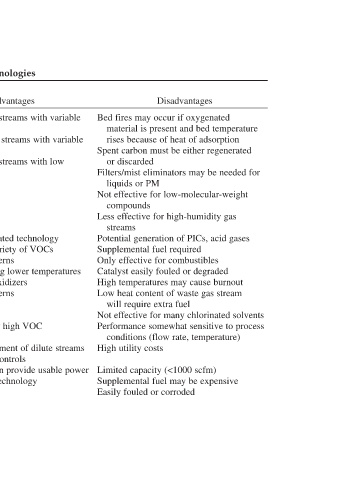Page 511 - Air Pollution Control Engineering
P. 511
12_ch_wang.qxd 05/05/2004 5:27 pm Page 482
Bed fires may occur if oxygenated rises because of heat of adsorption or discarded liquids or PM Not effective for low-molecular-weight compounds Less effective for high-humidity gas streams Potential generation of PICs, acid gases Supplemental fuel required Only effective for combustibles Catalyst easily fouled or degraded High temperatures may cause burnout Low hea
Disadvantages material is present and bed temperature Spent carbon must be either regenerated Filters/mist eliminators may be needed for Not effective for many chlorinated solvents Performance somewhat sensitive to process
Effective for gas streams with variable flow rates VOC content Effective for gas streams with low VOC content Widely demonstrated technology Effective for a variety of VOCs No disposal concerns Requires operating lower temperatures than thermal oxidizers No disposal concerns Effective for very high VOC concentrations Good for pretreatment of dilute streams prio
Advantages Effective for gas streams with variable Compact units can provide usable power
Point-Source VOC Controls by Emerging and Conventional Technologies
Applicable remediation technologies SVE, air stripping, thermal destruction, bioremediation, thermal desorption, solidification/stabilization, soil washing, etc. All remediation technologies SVE, air stripping SVE, air stripping, biotreatment SVE, air stripping
Carbon adsorption Thermal oxidation (incineration) Catalytic oxidation (Incineration) Internal combustion
Table 6 Control Condensers engines
482

